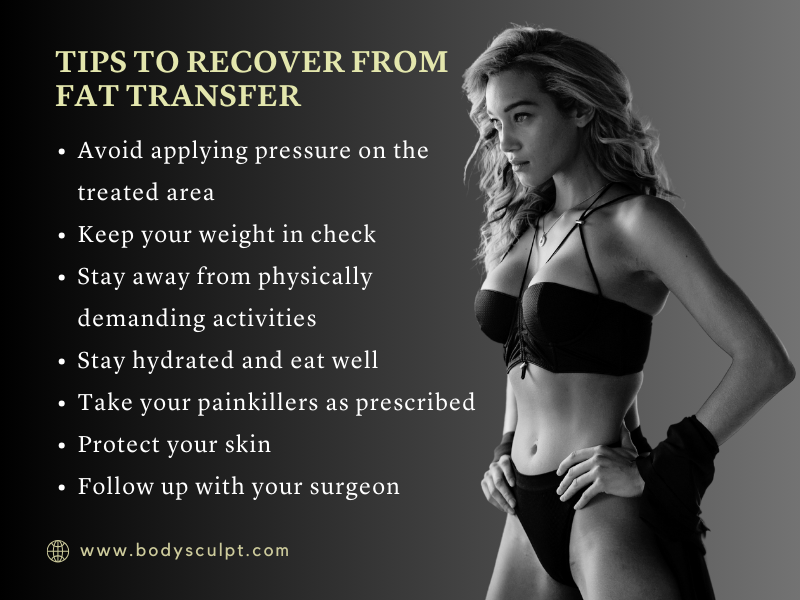Fat transfer procedures have become popular in recent years for enhancing various body areas using the body’s own fat. This technique is commonly used for augmenting the face, breasts, and buttocks, and involves removing fat from one area of the body, purifying it, and re-injecting it into the desired area. For those considering fat transfer in NYC, understanding the recovery and aftercare process is essential to ensure safe, successful results and minimize downtime.
Table of Contents

Fat Transfer in NYC – What Does It Involve?
Earlier, fat was thrown away as medical waste using liposuction. But today, the fat that is removed after liposuction can be transferred to another area of your body, but it cannot be shared. In order to smoothen out wrinkles, improve areas like the cheeks that lose volume with age, and enhance the buttocks, many women are now opting for fat transfer.
The two primary components of the Brazilian butt lift treatment are liposuction and fat transfer. BBL involves employing liposuction to remove fat from locations where it is plentiful, processing it, and then re-implanting it into the buttocks using fat grafting. Common donor locations include the abdomen, thighs, hips, and lower back. This minimally invasive procedure securely adds volume to your posterior and gives it a perky, prominent appearance by using your own fat in place of manufactured butt implants.

How to Recover from Fat Transfer
- Avoid applying pressure on the treated area: It is necessary to give the fat grafts time and space to stabilize and establish a connection with the local blood supply. During this phase, your body may absorb 20–40% of the fat cells. Avoiding direct pressure on the treated area is the greatest strategy to preserve the fragile fat cells and increase fat cell survival during the early stages of recovery. The first three weeks of healing are often the necessary time frame.
- Keep your weight in check: Maintaining a constant body weight can help to maintain the volume of fat transfer. As the grafted fat functions similarly to other fat cells in the body, weight fluctuations will affect the surgical outcome. Because of this, our surgeons advise patients to have this treatment only after they have achieved their goal weight and are able to sustain it over time with a healthy diet and way of life.
- Take your painkillers as prescribed: In order to help you during the healing process, the surgeon will prescribe painkillers. It’s crucial to take them exactly as prescribed; you shouldn’t take them on an empty stomach or with alcohol. Also, during your recuperation, avoid taking any additional medications without first talking to your surgeon.
- Stay away from physically demanding activities: You should stay away from physically demanding activities for a few weeks following the fat transfer treatment since your body needs time to heal. Furthermore, putting too much strain on your body too quickly can damage fat cell viability, which could compromise the outcomes you want. As soon as you feel well enough, it is best to go for brief walks to improve blood circulation, lower the chance of blood clots, and lessen the risks associated with the procedure.
- Stay hydrated and eat well: Hydration and a balanced diet rich in vitamins and minerals can support healing and cell survival. Avoid smoking during recovery, as it can interfere with blood circulation and reduce the fat cells’ survival rate.
- Protect your skin: For facial fat transfer, keep your skin protected from sun exposure to prevent premature aging and sun damage. Wear sunscreen and follow a regular skincare routine.
- Follow up with your surgeon: Routine follow-ups with your surgeon allow them to monitor your healing process and address any concerns. It’s also an opportunity to discuss any additional or touch-up procedures, if needed.
For those considering fat transfer in NYC, knowing what to expect during recovery and aftercare is essential for achieving optimal, long-lasting results. By following aftercare instructions, wearing compression garments, and allowing sufficient healing time, you can enjoy enhanced contours and a more natural look with minimal downtime. Remember, consulting an experienced surgeon and adhering to their recovery guidelines are the first steps toward a successful fat transfer experience. Whether you’re enhancing facial volume, achieving fuller breasts, or reshaping your silhouette, proper aftercare makes all the difference in your final results.
Ready to enhance your natural contours?
Schedule a consultation for fat transfer in NYC
